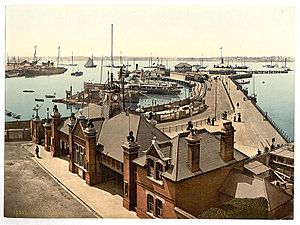Royal Pier, Southampton facts for kids

The pier sometime between 1891 and 1900
|
|
| Locale | Southampton |
|---|---|
| Construction | 1830s |
| Total length | 900-foot (270 m) |
| Opening date | 8 July 1833 |
| Destruction date | 31 December 1979 |
| Coordinates | 50°53′43″N 1°24′30″W / 50.89538°N 1.40831°W |
|
Listed Building – Grade II
|
|
| Official name | Royal Pier And Entrance Building |
| Designated | 4 January 1980 |
| Reference no. | 1179259 |
The Royal Pier (once known as Victoria Pier) is a long structure built out over the water in Southampton, United Kingdom. It was constructed in the 1830s during the Victorian era. This important pier served the city for many years until it closed its doors in late 1979.
Contents
History of the Royal Pier
Building the Pier in the 1800s
The Royal Pier is about 900-foot (270 m) long. It first opened on July 8, 1833. Princess Victoria herself opened it, and it was named Victoria Pier at the time. The main reason for building it was to give steamboats a good place to dock. Before the pier, passengers had to walk through muddy areas or use the busy Town Quay.
People had tried to get money for a pier in 1825 and 1828. Finally, in November 1829, the harbour board agreed to build one. A special law was passed in 1831 to allow the pier's construction. The project was paid for with a loan. Edward L Stephens, a Royal Navy officer, designed the pier.
Early Challenges and Changes
Soon after it was finished, the pier faced a big problem: tiny sea worms called gribble worms. These worms damaged the pier's wooden foundations. So, in 1838, the foundations had to be rebuilt. To stop the worms, workers covered the pier's wooden posts with large-headed nails. They hoped the rust from the nails would protect the wood.
In 1847, a special tramway was built. This tramway, pulled by horses, connected the pier to the Southampton Terminus railway station. In 1871, the tramway was made even longer, reaching the very end of the pier. A small station with one platform was built there. By 1876, the trams switched from horses to small steam engines. The LSWR company eventually owned five of these special steam locomotives. Later, in the early 1900s, two railcars were added. In 1888, the pier got a new gatehouse, which is the building at the entrance.
Rebuilding and New Features
Between 1891 and 1893, the pier was completely rebuilt using strong iron. The station was made bigger, with two platforms. New features were added to make the pier a fun place for people to visit, like a large pavilion. This money came from a big loan of £100,000. This loan also helped pay for making the harbour deeper. The newly rebuilt pier officially opened in 1902. Prince Arthur, Duke of Connaught and Strathearn, a member of the Royal Family, opened it.
In 1894, the gatehouse was made even larger. Four years later, a new floating dock (called a pontoon) was added. This allowed two steamboats to dock at the pier at the same time. Around this time, the pier was renamed the Royal Pier.
The Pier in the 1900s
When World War I began, public tram services to the pier's station stopped on October 1, 1914. During the war, a ship accidentally crashed into the pier, causing damage. This damage meant the tram line could not reopen after the war, and it officially closed in 1921.
The pavilion, a large building on the pier, was made bigger in 1922. It could hold up to 1000 people and became a very popular place for dancing. The gatehouse was rebuilt again in 1930. During World War II, the pier was closed to the public for safety. It reopened in 1947.
In the 1950s, the pier was changed to handle new types of ferries called RoRo ferries. These ferries allow cars to drive on and off easily. This happened when Red Funnel introduced their MV Carisbrooke Castle ferry. In 1963, the pavilion was updated and turned into a grand ballroom.
Closure and What Happened Next
The Royal Pier closed its doors for good at the end of 1979. The gatehouse, the building at the entrance, was reopened as a restaurant in 1986. However, a fire on May 4, 1987, badly damaged many parts of the pier. In 1992, another fire damaged the restaurant. The restaurant eventually reopened in 2008, serving Thai food. The gatehouse is now a "Grade II" listed building, which means it's an important historical building that needs to be protected.
As of 2020, the pier is still in a very poor state. Many people have asked for it to be fixed up or rebuilt. In 2015, there was a big plan for a £450 million project. This plan wanted to turn the area into a fancy waterside development with homes, shops, a hotel, and a casino. However, this plan did not move forward and was officially stopped by Southampton City Council on August 23, 2019.
Images for kids




